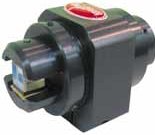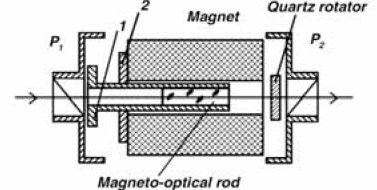 rotation
to isolate the source and protect the laser oscillator from reflections in an
optical system. In other words, they basically act as an optical diode allowing
the propagation of light in only one direction.
rotation
to isolate the source and protect the laser oscillator from reflections in an
optical system. In other words, they basically act as an optical diode allowing
the propagation of light in only one direction. Del Mar Photonics - Kirra Faraday Rotators and Isolators
Del Mar Photonics - Newsletter Fall 2010 - Newsletter Winter 2010
From discussions in multiphoton microscopy forum:
Question:
I am considering placing a Faraday rotator or isolator in front of a two-photon
laser and am wondering what others have experienced with such a configuration.
I am currently experiencing a lot of "feedback", ie return reflected laser, that
is wrecking havoc with my laser's stability. When it senses the reflected light,
it can not maintain a mode locked state and can only lase in CW.
I'm heard that a Faraday rotator should be sufficient, but I am wondering if an
isolator is necessary to stop the reflected light from entering the cavity of
the laser source. Also, I would love to get a recommendation for a reliable
company that makes them.
Answer:
An isolator is simply a Faraday rotator sandwiched with two polarizers. Without those polarizers, your feedback into the laser cavity (i.e.back-reflection) will be orthogonally polarized to the output beam. It is likely that the laser will be little disturbed in this case, because the TiSap laser cavity favors one polarization. However complete (>30dB) suppression of feedback will be achieved only with an isolator. Please also keep in mind the group-velocity dispersion, if you are using <30fs pulses.
A Faraday rotator isolator is a large chunk of crystal. It will cause a lot
of dispersion to your pulses if you are using a femtosecond laser. Our own laser
went from 70fs to 300fs after passing through ours. This effect can be minimized
by getting as short a crystal as possible in your isolator. We originally
selected ours based on the assumption that the smallest entrance aperture will
have the shortest crystal. This turned out to not be the case, so check with the
company before buying.
Regarding the utility of an isolator, if you have any reflections at all having
one is critical for the stability of your laser. In some laser designs the
reflected light can actually be physically harmful to the laser as well!
Q & A - What is a Faraday Optical Isolator and How Does it Work?
Del Mar Photonics - Kirra Faraday Isolator brochure - Faraday Isolator Models - Request a quote
At high powers optical feedback can damage or disrupt the operation of a
laser system. To reduce this feedback, an optical isolator can be inserted into
the system. Faraday optical isolators (based on the Faraday effect) are passive
unidirectional, nonreciprocal devices that utilize the phenomenon of
magneto-optic
 rotation
to isolate the source and protect the laser oscillator from reflections in an
optical system. In other words, they basically act as an optical diode allowing
the propagation of light in only one direction.
rotation
to isolate the source and protect the laser oscillator from reflections in an
optical system. In other words, they basically act as an optical diode allowing
the propagation of light in only one direction.
Faraday isolators (see Figure 1) typically consist of a Faraday rotator, two
polarizers, and a body to house the parts. The Faraday rotator, in turn,
consists of magnetooptically active optical material placed inside a permanent
magnet (Nd-Fe-B).
In the Faraday optical isolator shown in Figure 2, the magneto-optical rod
(located inside the Faraday rotator) is cut from glass (MOS-10) polished to
flatness of
![]() /10, and
has parallelism better than 10 arc seconds.
/10, and
has parallelism better than 10 arc seconds.
 It
is anti-reflection coated with residual reflection <0.2% (each side) in the
765-835 nm range. The polarizers are air-spaced Glan prisms made of calcite.
Entrance and exit faces of polarizers are anti-reflection coated with residual
reflection of <0.3% in the range. Polarizer transmittance is >98%. This gives a
total transmittance of better than 85% for the isolator.
It
is anti-reflection coated with residual reflection <0.2% (each side) in the
765-835 nm range. The polarizers are air-spaced Glan prisms made of calcite.
Entrance and exit faces of polarizers are anti-reflection coated with residual
reflection of <0.3% in the range. Polarizer transmittance is >98%. This gives a
total transmittance of better than 85% for the isolator.
Laser light (polarized or unpolarized) enters the input polarizer (P1) and is linearly polarized to 0°. Next, the linearly polarized light enters the Faraday rotator rod (magneto-optical rod). The plane of polarization rotates as the light propagates along the axis of the rod. The Faraday rotator is tuned to rotate the plane of polarization by 45°. (Changing the position of the rod allows tuning over a wavelength range from 765-835 nm.) The light then passes through the output polarizer (P2) whose transmission axis is also at 45°.
Any back reflected light re-enters the isolator through the output polarizer and becomes polarized at 45°. The back reflected light then passes through the Faraday rotator, which produces another 45° of rotation, and is now polarized at 90°, or horizontally, before being stopped by the input polarizer, still at 0°. Thus, the laser is isolated from its own reflections that may occur in the application part of the optical set.
This information was contributed by Sergey Egorov for Del Mar Photonics, located in San Diego, CA.
Del Mar Photonics - Kirra Faraday Isolator brochure - Faraday Isolator Models